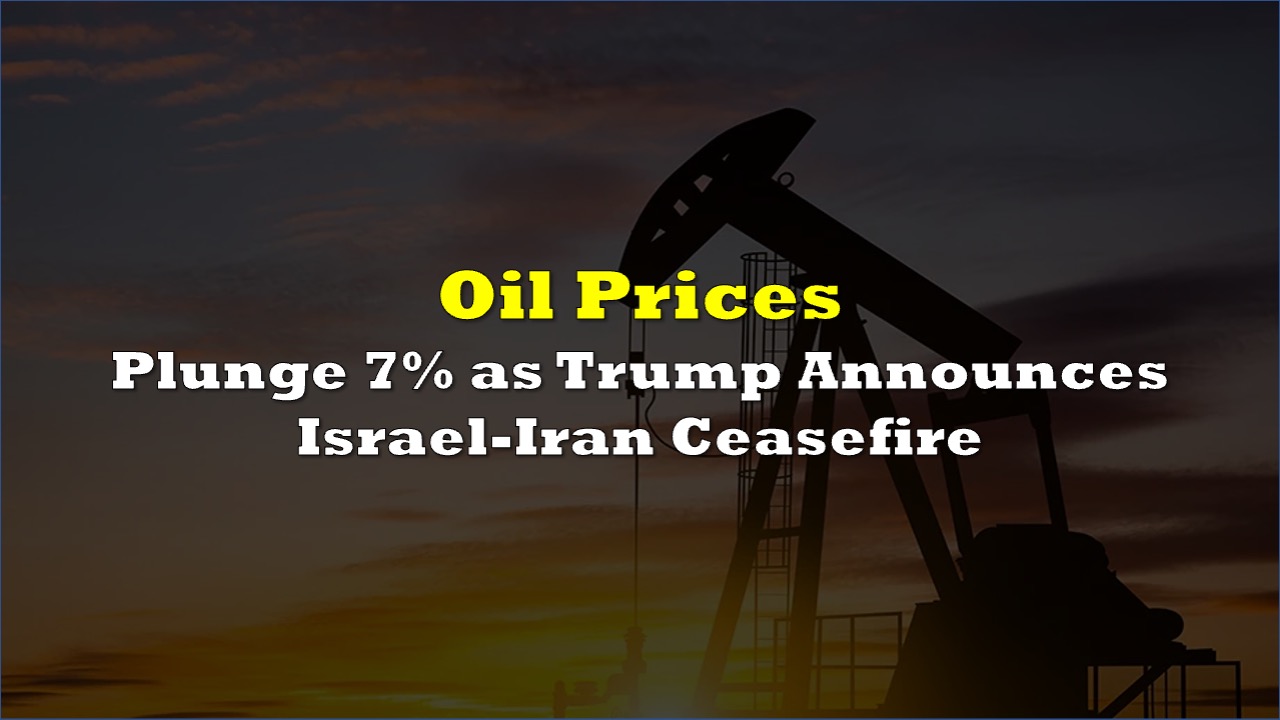President Donald Trump’s announcement of an Israel-Iran ceasefire triggered a massive selloff in oil markets Monday, with crude prices posting their biggest single-day decline in nearly two years as investors welcomed a potential end to Middle East hostilities.
Brent crude, the global benchmark, plummeted $5.53 to close at $71.48 per barrel, a 7.2% decline that marked the largest daily drop since August 2022. US crude fell by the same percentage to $68.51 per barrel.
Crude now down a full $5/bbl from pre-missile attack levels 💀
— Rory Johnston (@Rory_Johnston) June 23, 2025
Trump said Monday that Israel and Iran had agreed to a “complete and total ceasefire,” calling the conflict the “12 day war” in a social media post. The announcement came after Iran launched a limited missile attack on a US military base in Qatar, retaliating for American strikes on three Iranian nuclear facilities over the weekend.
“It has been fully agreed by and between Israel and Iran that there will be a Complete and Total CEASEFIRE,” Trump wrote, adding that the conflict was “set to end in a ceasefire.”
It looks as if the geopolitical risk premium is being priced out again. #Oil prices collapse after Trump announces ceasefire between Israel and Iran. pic.twitter.com/uHZIBRDI4k
— Holger Zschaepitz (@Schuldensuehner) June 23, 2025
Markets had feared Iran might retaliate by blocking the Strait of Hormuz, the narrow waterway through which more than a quarter of seaborne oil passes daily. Instead, Tehran launched a limited strike against US forces in Qatar, avoiding energy infrastructure entirely.
“Oil flows for now aren’t the primary target and are likely not to be impacted,” said John Kilduff, a partner at Again Capital. “I think it’s going to be military retaliation on US bases and/or trying to hit more of the Israeli civilian targets.”
Fighting erupted June 13 with Israeli airstrikes targeting Iranian nuclear and military sites. The crisis intensified eight days later when Trump authorized American forces to bomb three Iranian nuclear facilities using massive 30,000-pound munitions.
The US military deployed 30,000-pound GBU-57 “Massive Ordnance Penetrator” bombs specifically designed to destroy heavily fortified underground targets. Trump declared the operation had “completely and totally obliterated” Iran’s key nuclear facilities.
The missile strike on Qatar’s Al Udeid Air Base represented Iran’s first direct military response to American forces since the weekend nuclear facility bombings. According to Trump, Iranian forces fired 14 missiles at the sprawling military installation, with US air defenses intercepting 13 projectiles.
Iran’s Foreign Minister Abbas Araghchi said his country would halt attacks if Israel ceased its military operations, though the role of Supreme Leader Ayatollah Ali Khamenei in ceasefire negotiations remained unclear. The White House credited Qatar’s government with playing a crucial mediating role, with Trump personally thanking the Qatari emir for facilitating the agreement.
Trump had previously called for Iran’s “unconditional surrender” and threatened additional strikes if the conflict continued. The president faces criticism from some lawmakers for ordering the Iran strikes without congressional approval.
As oil prices spiked during the conflict, Trump took to his Truth Social platform to address the US Department of Energy, urging increased domestic production with his signature phrase “drill, baby, drill” and adding “I mean now.” The president expressed a desire to keep oil prices down amid fears that Middle East fighting could drive them higher.
— Rory Johnston (@Rory_Johnston) June 23, 2025
Energy analysts said the oil price decline reflected reduced fears of supply disruptions, though geopolitical risks remain elevated in the region.
Goldman Sachs analysts warned that oil prices could still hit $110 a barrel if the Strait of Hormuz is blocked, while HSBC analysts see prices potentially topping $80 in such a scenario.
Gasoline prices nationwide had climbed during the crisis, reaching an average $3.19 per gallon — up 7 cents from pre-conflict levels, according to GasBuddy data. Energy analysts expect pump prices to retreat if the ceasefire proves durable.
WTI Crude last traded at $65.14, while Brent currently sits at $68.00.
Information for this story was found via the sources and companies mentioned. The author has no securities or affiliations related to the organizations discussed. Not a recommendation to buy or sell. Always do additional research and consult a professional before purchasing a security. The author holds no licenses.









